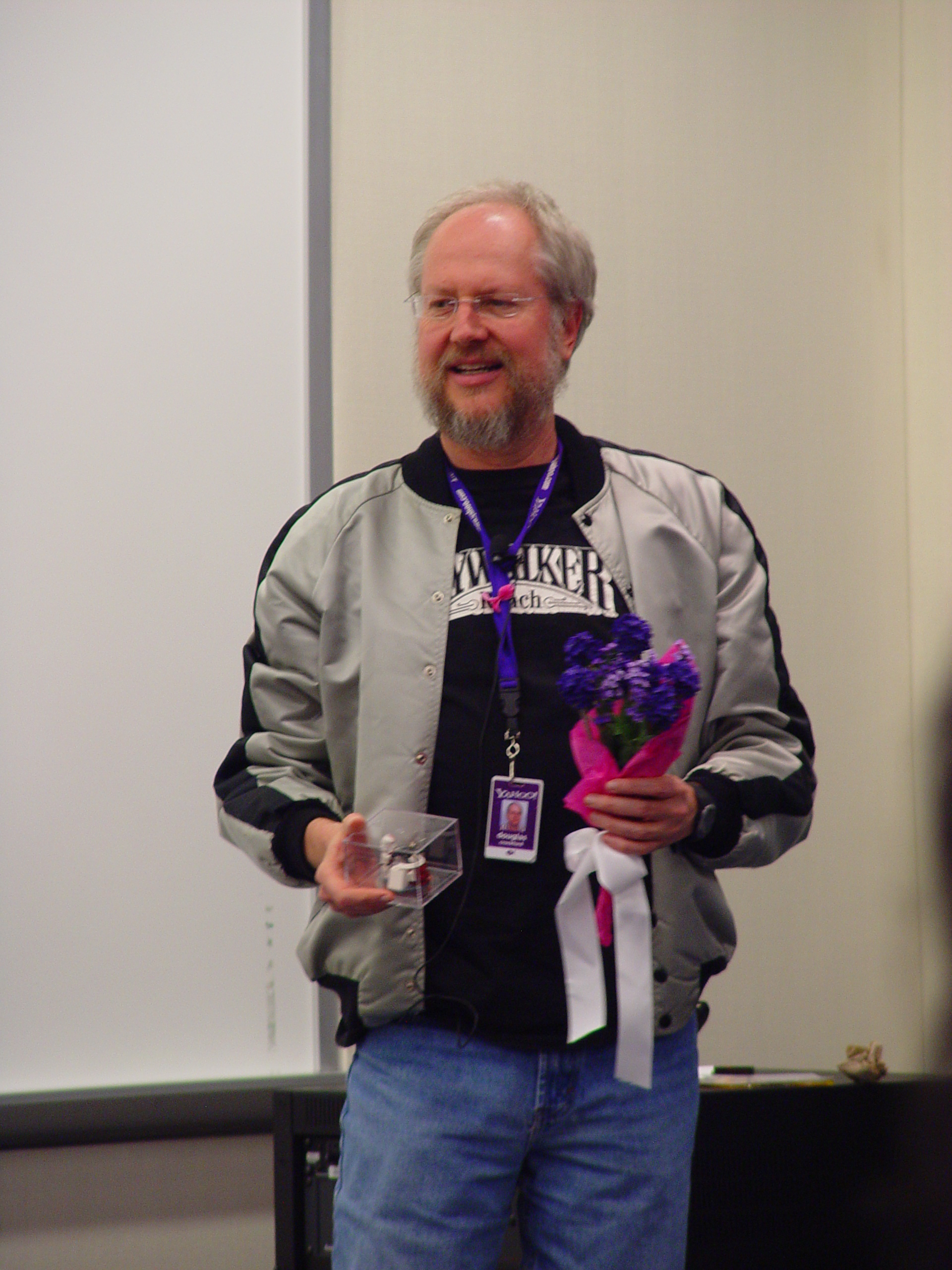|
Tritium (programming Language)
Tritium is a simple scripting language for efficiently transforming structured data like HTML, XML, and JSON. It is similar in purpose to XSLT but has a syntax influenced by jQuery, Sass, and CSS versus XSLT's XML based syntax. History Tritium was designed by Hampton Catlin, the creator of languages Sass and Haml and is currently bundled with the Moovweb mobile platform. As with Sass (created to address deficiencies in CSS) and Haml (created to address deficiencies in coding HTML templates), Catlin designed Tritium to address issues he saw with XSLT while preserving the core benefits of a transformation language. Much of this was based on his prior experience porting Wikipedia's desktop website to the mobile web. Open Tritium is the open source implementation of the Tritium language. It was presented at O'Reilly Open Source Convention 2014 and the compiler is implemented in Go. Concept Tritium takes as input HTML, XML, or JSON documents and outputs HTML, XML, or JS ... [...More Info...] [...Related Items...] OR: [Wikipedia] [Google] [Baidu] |
Hampton Catlin
Hampton Lintorn-Catlin (; born 1982) is an American computer programmer, programming language inventor, gay rights advocate, and author, best known as the creator of the Sass (style sheet language), Sass and Haml markup languages. Hampton was a Vice President of Engineering at Rent the Runway, and has previously held similar roles at Moovweb, Thriveworks, and at the Wikimedia Foundation. Creations Haml He created a markup language called Haml which he intended to be a radically different design for inline page templating systems like eRuby in Ruby. Since its initial release in 2006, Haml has been ported to several other languages and has been the design inspiration for other languages like Slim (computer language), Slim. It's the second most popular templating language for the Ruby on Rails framework. Sass In 2007, Lintorn-Catlin created a style sheet language to expand on Cascading Style Sheets (CSS), used to describe presentation semantics of web pages. Catlin continued t ... [...More Info...] [...Related Items...] OR: [Wikipedia] [Google] [Baidu] |
XSLT
XSLT (Extensible Stylesheet Language Transformations) is a language originally designed for transforming XML documents into other XML documents, or other formats such as HTML for web pages, plain text, or XSL Formatting Objects. These formats can be subsequently converted to formats such as PDF, PostScript, and PNG. Support for JSON and plain-text transformation was added in later updates to the XSLT 1.0 specification. XSLT 3.0 implementations support Java, .NET, C/C++, Python, PHP and NodeJS. An XSLT 3.0 JavaScript library can also be hosted within the web browser. Modern web browsers also include native support for XSLT 1.0. The XSLT document transformation specifies how to transform an XML document into new document (usually XML, but other formats, such as plain text are supported). Typically, input documents are XML files, but anything from which the processor can build an XQuery and XPath Data Model can be used, such as relational database tables or geographical inform ... [...More Info...] [...Related Items...] OR: [Wikipedia] [Google] [Baidu] |
Sass (stylesheet Language)
Sass (short for ''syntactically awesome style sheets'') is a preprocessor scripting language that is interpreted or compiled into Cascading Style Sheets (CSS). SassScript is the scripting language itself. Sass consists of two syntaxes. The original syntax, called "the indented syntax," uses a syntax similar to Haml. It uses indentation to separate code blocks and newline characters to separate rules. The newer syntax, SCSS (Sassy CSS), uses block formatting like that of CSS. It uses braces to denote code blocks and semicolons to separate rules within a block. The indented syntax and SCSS files are traditionally given the extensions .sass and .scss, respectively. CSS3 consists of a series of selectors and pseudo-selectors that group rules that apply to them. Sass (in the larger context of both syntaxes) extends CSS by providing several mechanisms available in more traditional programming languages, particularly object-oriented languages, but that are not available to CSS3 i ... [...More Info...] [...Related Items...] OR: [Wikipedia] [Google] [Baidu] |
XML Transformation Language
An XML transformation language is a programming language designed specifically to transform an ''input'' XML document into an ''output'' document which satisfies some specific goal. There are two special cases of transformation: * XML to XML: the ''output document'' is an XML document. * XML to Data: the ''output document'' is a byte stream. XML to XML As XML to XML transformation outputs an XML document, XML to XML transformation chains form XML pipelines. XML to Data The XML (EXtensible Markup Language) to Data transformation contains some important cases. The most notable one is XML to HTML (HyperText Markup Language), as an HTML document ''is not'' an XML document. SGML origins The earliest transformation languages predate the advent of XML as an SGML profile, and thus accept input in arbitrary SGML rather than specifically XML. These include the SGML-to-SGML link process definition (LPD) format defined as part of the SGML standard itself; in SGML (but not XML), the LPD ... [...More Info...] [...Related Items...] OR: [Wikipedia] [Google] [Baidu] |
HTML
Hypertext Markup Language (HTML) is the standard markup language for documents designed to be displayed in a web browser. It defines the content and structure of web content. It is often assisted by technologies such as Cascading Style Sheets (CSS) and scripting languages such as JavaScript, a programming language. Web browsers receive HTML documents from a web server or from local storage and browser engine, render the documents into multimedia web pages. HTML describes the structure of a web page Semantic Web, semantically and originally included cues for its appearance. HTML elements are the building blocks of HTML pages. With HTML constructs, HTML element#Images and objects, images and other objects such as Fieldset, interactive forms may be embedded into the rendered page. HTML provides a means to create structured documents by denoting structural semantics for text such as headings, paragraphs, lists, Hyperlink, links, quotes, and other items. HTML elements are delineated ... [...More Info...] [...Related Items...] OR: [Wikipedia] [Google] [Baidu] |
JSON
JSON (JavaScript Object Notation, pronounced or ) is an open standard file format and electronic data interchange, data interchange format that uses Human-readable medium and data, human-readable text to store and transmit data objects consisting of name–value pairs and array data type, arrays (or other serialization, serializable values). It is a commonly used data format with diverse uses in electronic data interchange, including that of web applications with server (computing), servers. JSON is a Language-independent specification, language-independent data format. It was derived from JavaScript, but many modern programming languages include code to generate and parse JSON-format data. JSON filenames use the extension .json. Douglas Crockford originally specified the JSON format in the early 2000s. Transcript: He and Chip Morningstar sent the first JSON message in April 2001. Naming and pronunciation The 2017 international standard (ECMA-404 and ISO/IEC 21778:2017) ... [...More Info...] [...Related Items...] OR: [Wikipedia] [Google] [Baidu] |
Haml
Haml (HTML Abstraction Markup Language) is a templating system that is designed to avoid writing inline code in a web document and make the HTML cleaner. Similar to other template systems like eRuby, Haml also embeds some code that gets executed during runtime and generates HTML code in order to provide some dynamic content. In order to run Haml code, files need to have a extension. These files are similar to .erb or .eRuby files, which also help embed Ruby code while developing a web application. While parsing code comments, Haml uses the same rules as Ruby 1.9 or later. Haml understands only ASCII-compatible encodings, like UTF-8, but not UTF-16, or UTF-32, because these are not compatible with ASCII. Haml can be used at the command line, as a separate Ruby module, or in a Ruby on Rails application. History Haml was originally introduced by Hampton Catlin with its initial release in 2006 and his work was taken up by a few other people. His motive was to make HTML simple ... [...More Info...] [...Related Items...] OR: [Wikipedia] [Google] [Baidu] |
Moovweb
Layer0 (previously Moovweb), is an American software company based in San Francisco, California, providing infrastructure to run dynamic websites frontends. The company was founded in 2009 by Ajay Kapur and Ishan Anand with $700,000 invested by Andy Bechtolsheim, and has since raised $16.7 million in venture funding. The company helped integrate Google Wallet into the 1-800-Flowers.com mobile site. Moovweb is a Google Wallet Premium Platform Partner. Moovweb has employed PayPal Express checkout on some of the sites it has developed. Moovweb has rebranded itself as Layer0 in April 24, 2021.Ias acquired by Edgio Edgio, Inc., formerly Limelight Networks, was an American company that provides a content delivery network (CDN) service, used for delivery of digital media content and software. Following a 2022 acquisition of Edgecast, the company re-brande .... References Software companies based in the San Francisco Bay Area Defunct software companies of the United States< ... [...More Info...] [...Related Items...] OR: [Wikipedia] [Google] [Baidu] |
O'Reilly Open Source Convention
The O'Reilly Open Source Convention (OSCON) was an American annual convention for the discussion of free and open-source software. It was organized by publisher O'Reilly Media and was held each summer, mostly in Portland, Oregon, from 1999 to 2019. History OSCON grew out of The Perl Conference, but the amount of Perl content continued to decline each year. The first Perl Conference took place in 1997. The first OSCON was held in 1999. ;Notable events * The OpenOffice.org open source project was announced at the 2000 conference in Monterey. * The OpenStack open source project was launched at the 2010 conference. * OSCON has been the host to Larry Wall's State of the Onion keynotes. * All O'Reilly events were cancelled in response to the COVID-19 pandemic The COVID-19 pandemic (also known as the coronavirus pandemic and COVID pandemic), caused by severe acute respiratory syndrome coronavirus 2 (SARS-CoV-2), began with an disease outbreak, outbreak of COVID-19 ... [...More Info...] [...Related Items...] OR: [Wikipedia] [Google] [Baidu] |
Go (programming Language)
Go is a high-level programming language, high-level general purpose programming language that is static typing, statically typed and compiled language, compiled. It is known for the simplicity of its syntax and the efficiency of development that it enables by the inclusion of a large standard library supplying many needs for common projects. It was designed at Google in 2007 by Robert Griesemer, Rob Pike, and Ken Thompson, and publicly announced in November of 2009. It is syntax (programming languages), syntactically similar to C (programming language), C, but also has memory safety, garbage collection (computer science), garbage collection, structural type system, structural typing, and communicating sequential processes, CSP-style concurrency (computer science), concurrency. It is often referred to as Golang to avoid ambiguity and because of its former domain name, golang.org, but its proper name is Go. There are two major implementations: * The original, Self-hosting (compi ... [...More Info...] [...Related Items...] OR: [Wikipedia] [Google] [Baidu] |
XPath
XPath (XML Path Language) is an expression language designed to support the query or transformation of XML documents. It was defined by the World Wide Web Consortium (W3C) in 1999, and can be used to compute values (e.g., strings, numbers, or Boolean values) from the content of an XML document. Support for XPath exists in applications that support XML, such as web browsers, and many programming languages. The XPath language is based on a tree representation of the XML document, and provides the ability to navigate around the tree, selecting nodes by a variety of criteria. In popular use (though not in the official specification), an XPath expression is often referred to simply as "an XPath". Originally motivated by a desire to provide a common syntax and behavior model between XPointer and XSLT, subsets of the XPath query language are used in other W3C specifications such as XML Schema, XForms and the Internationalization Tag Set (ITS). XPath has been adopted by a num ... [...More Info...] [...Related Items...] OR: [Wikipedia] [Google] [Baidu] |



